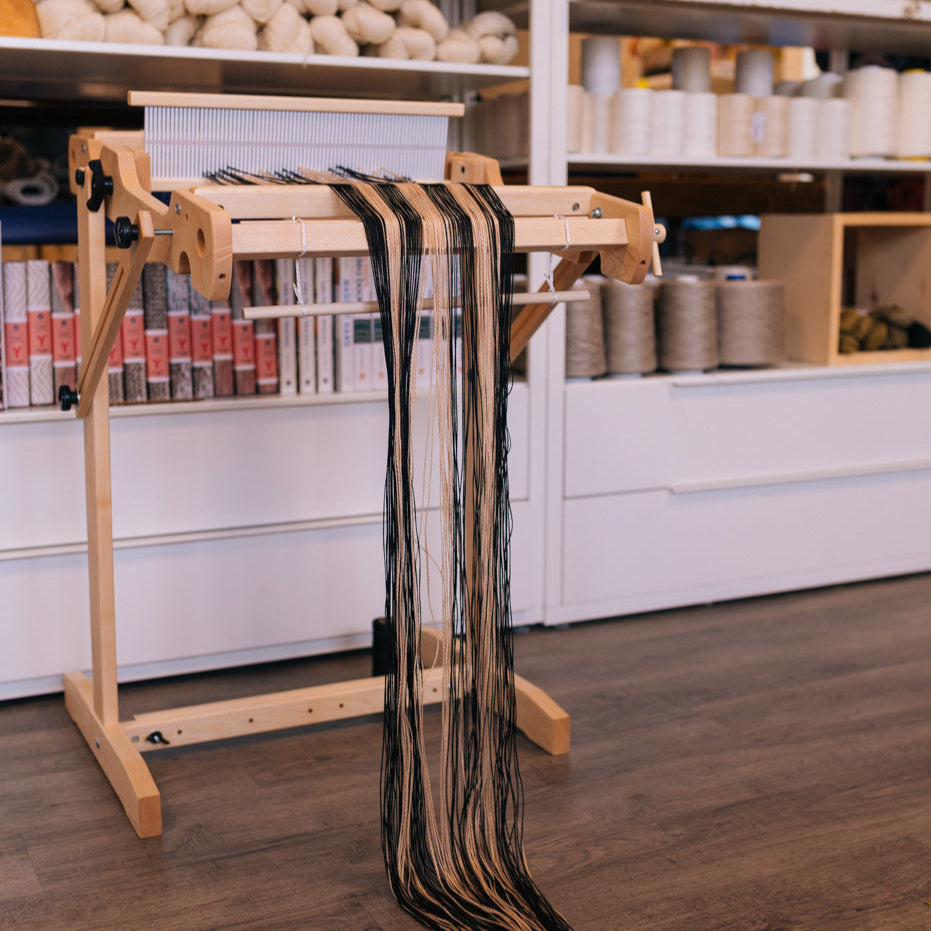Rigid heddle looms are a great entry point into the world of weaving. Brand new weavers can quickly whip off a pile of beautiful projects on an Ashford, Flip or a Bergere. But if you’ve already made a drawer full of dish towels or given scarves to everyone in your family, you may be curious about what you can do with your rigid heddle loom beyond straightforward plain weave. You’re in luck! There are plenty of ways to change up the structure, texture, and aesthetic of your weaving with your rigid heddle loom.

Get into Colour and Weave
Do you love contrasting colours and tidy geometric patterns? Colour-and-weave pieces use particular patterns of colour in the warp and weft to give the appearance of solid lines, decorative dots, grids, crosses, and much more… despite still being plain weave. Houndstooth is perhaps the most popular example of colour-and-weave. Another popular colour-and-weave pattern, log cabin, produces super cool 3D effects. Weaving these patterns means putting careful planning into your warping and being careful to keep the correct colour order in your threading. It will teach you how to handle two shuttles at once, which unlocks a whole new world of colour possibilities. The extra effort you put in more than pays off in fun and impressive results. Check out our “Colour-and-Weave Towels” pattern for an easy starting point, or pick up a copy of The Weaver’s Idea Book for dozens of colour-and-weave options.

Pick up a pick up stick
This is the fastest (and for me, the most satisfying) way to add texture to your rigid heddle piece. You know those skips that happen in your weaving where your weft jumps out of the over-under-over-under pattern of plain weave and makes a raised line of thread on the surface of your work? Pick up sticks let you do that on purpose. A pick up stick is a flat stick that lives behind the heddle. As you weave, you can turn and slide it to manipulate some of the threads that are in the slots of your loom to create ‘floats’ (which is what you call skips when they’re not a mistake).
Creating weft and warp floats can add thickness and softness, create beautiful visual effects, or even open little lacy windows in your weaving. The Weaver’s Idea Book is a great resource, again. Or if this all sounds a little mysterious, you can take a workshop with us to get some guidance mastering pick up sticks.
Try some finger-manipulated techniques
Pick up sticks are great, but sometimes you’ve just got to get your hands in there. Finger-manipulated techniques are ways to twist, wrap, and tweak your warp and weft with your fingers to produce intricate, delicate effects. If you like curvy lines, take a look a leno: pairs of warp threads are twisted over each other and pinned in place with a pick of weft to create smooth, twisty waves. Brook’s Bouquet is great for lightweight pieces and window-coverings: the weft is wrapped around bundles of warp threads, opening up windows in the weave.
Finger-manipulated techniques are beautiful, but they are slow. It’s best not to start by using them for an entire piece--I learned this lesson the hard way! Build up your confidence by adding a few lines of leno or Brook’s Bouquet to the ends of a scarf or table runner, and get more adventurous from there.

About that simple old plain weave…
Are you sure you’re really sick of it? Changing up the weight of yarn you work with can also bring new life to your weaving. If you’re using the 8-dent reed that came with your loom, try picking up a 10-dent or even a 12-dent reed to experiment with making finer fabric. Or if you’re feeling burnt out on fine yarn and want some quick wins to get your weaving mojo going again, you can head in the other direction and go super chunky with a 5-dent reed.
Sometimes changing up your material can open up new challenges and new projects. If you’ve been mostly weaving wool scarves, try some cotton kitchen towels. If you’ve mastered cotton, see how your skills translate to a silk noil warp, or take on linen for more of a challenge. Combining different fibres in the same warp can be tricky, but can yield incredible results. How about a slubby Mallo cotton combined with some wool for a highly textured warp, or experimenting with some unusual fibres in our Mill Ends? Experimenting sparks creativity like nothing else. And as an added bonus, it’s a great excuse to go yarn shopping!
Rigid heddle looms are simple looms. That’s part of what’s so wonderful about them--they are inexpensive, small, and easy to learn. But even simple tools can create a wide range of beautiful weaving projects! Hopefully you find ways to get every last drop of creative possibility out of your rigid heddle loom.

